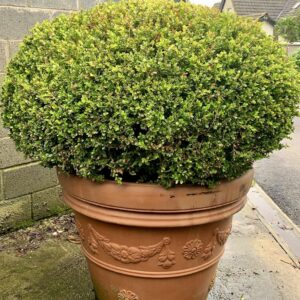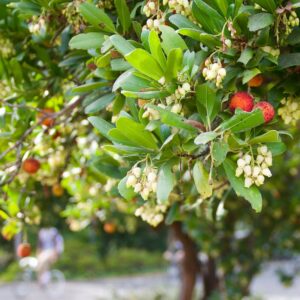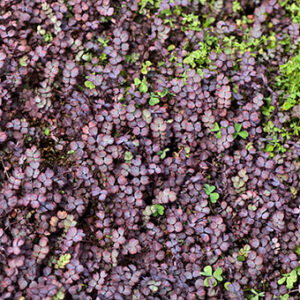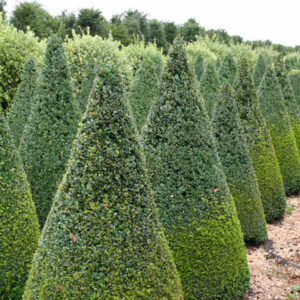The Fatsia japonica ‘Camouflage’
£25.00
Description
Quick Facts
- Common Name: Variegated Japanese Aralia, Camouflage Fatsia, Paper Plant
- Botanical Name: Fatsia japonica ‘Camouflage’
- Plant Type: Evergreen shrub
- Mature Height: 1.5-2.5m
- Mature Spread: 1.5-2m
- Flowering Period: October to November
- Flower Colour: Creamy-white spherical clusters
- Foliage: Large, glossy, palmate leaves with cream and grey-green variegation
- Hardiness: RHS H4 (hardy in most of UK and Ireland, may need protection in severe winters)
- Soil Requirements: Moist, well-drained, fertile soil; tolerates most soil types
- Aspect: Partial shade to full shade; sheltered position
- Maintenance: Low
Description
Experience the exotic architectural drama of Fatsia japonica ‘Camouflage’, the stunning variegated evergreen shrub that brings year-round tropical elegance to Irish gardens with its magnificent hand-shaped leaves splashed in cream, grey-green, and soft green tones. This outstanding cultivar offers remarkable qualities—bold palmate foliage measuring up to 40cm across creating instant architectural impact and lush jungle atmosphere, striking cream and grey-green variegation that illuminates shaded corners and brings light to dark spaces, glossy evergreen leaves providing structure and interest throughout all seasons including winter, creamy-white spherical flower clusters in autumn adding seasonal charm followed by black berries attractive to wildlife, and exceptional shade tolerance thriving in conditions where most plants struggle, making this one of the finest choices for adding exotic drama, year-round structure, and luminous variegated foliage to shaded Irish gardens, courtyard spaces, and sheltered urban areas.
Throughout the seasons, this captivating shrub displays its characteristic large palmate leaves—each leaf divided into 7-9 deeply lobed fingers radiating from central point like an elegant hand, creating bold architectural silhouette. The ‘Camouflage’ cultivar is prized for its exceptional variegation—leaves emerge splashed and mottled with cream, grey-green, and soft green in irregular patterns that resemble military camouflage (hence the name), with each leaf displaying unique markings ensuring no two are identical. The glossy leaf surface catches available light beautifully, making the variegation even more luminous and eye-catching in shaded positions. In autumn (October-November), mature plants produce rounded clusters of small creamy-white flowers held on branching stems above the foliage—these spherical umbels create architectural interest and attract late-season pollinators including bees. Following flowering, small black berries develop providing food for birds through winter months. The overall effect is exotic, tropical, and architecturally bold—like having a piece of jungle paradise in your Irish garden. The variegated foliage creates striking contrast against darker green plants and brings welcome brightness to shaded areas where colour is often lacking.
Fatsia japonica originates from the coastal woodlands of Japan and South Korea, where it grows naturally in sheltered, shaded forest understoreys—this heritage makes it perfectly suited to Irish conditions, particularly our mild, moist climate and shaded urban gardens. ‘Camouflage’ is a selected cultivar bred for its exceptional variegation and compact growth habit. The genus name Fatsia is derived from the Japanese word ‘fatsi’ meaning eight, referring to the typically eight-lobed leaves (though 7-9 lobes are common). Hardy to RHS H4, this shrub tolerates Irish winters reliably in most areas, though young plants and new growth may benefit from fleece protection during severe frosts or in exposed positions—established plants are remarkably tough. Thrives in our mild, maritime climate with consistent moisture and moderate temperatures. Growth habit is upright and bushy, forming rounded multi-stemmed shrub reaching 1.5-2.5m height with similar spread at maturity—growth rate is moderate, adding 20-30cm annually once established. Particularly valuable for its exceptional shade tolerance—this is one of the best evergreen shrubs for deep shade where few other plants will grow successfully. Also tolerates urban pollution, coastal conditions (in sheltered positions), and neglect once established, making it ideal for low-maintenance Irish gardens. The evergreen foliage provides year-round structure and screening. Excellent in containers for patios, courtyards, and sheltered balconies where its exotic appearance creates instant tropical atmosphere.
Create stunning compositions by planting Fatsia japonica ‘Camouflage’ as bold architectural focal point in shaded borders where its luminous variegated foliage draws the eye and illuminates dark corners, positioning beneath tree canopies or on north-facing walls where its shade tolerance excels, or using in sheltered courtyard gardens and urban spaces where its exotic appearance creates lush jungle atmosphere. Exceptional in woodland-style gardens combined with ferns (Dryopteris, Polystichum), hostas, and hellebores for layered shade planting, Japanese-inspired gardens paired with bamboos, acers, and ornamental grasses for authentic oriental aesthetic, or contemporary gardens where its bold architectural form provides striking contrast to minimalist design. Works beautifully planted in generous groups of 3-5 for dramatic impact, as evergreen screening in shaded areas where laurel would be too heavy, or in large containers (minimum 50cm diameter) for patios and entrance areas where its exotic foliage creates welcoming tropical statement. Magnificent combined with dark-leaved plants like Ophiopogon planiscapus ‘Nigrescens’ or purple-leaved heucheras where the cream variegation provides striking contrast, or with lime-green foliage plants like Hakonechloa macra ‘Aureola’ or golden hostas for luminous shade combinations. The autumn flowers attract late-season pollinators while winter berries provide food for birds. Perfect for adding exotic drama, year-round structure, and luminous variegated foliage to shaded Irish gardens, courtyard spaces, and sheltered urban areas.
Caragh Garden Notebook
Planting: Plant spring (March-May) or autumn (September-October) for best establishment, though container-grown plants can be planted year-round if ground isn’t frozen. Choose sheltered position in partial to full shade—avoid hot, sunny positions which scorch variegated foliage and cause leaf burn. Tolerates deep shade better than most evergreens. Requires shelter from cold winds and hard frosts which can damage foliage—ideal positions include north or east-facing walls, beneath tree canopies, in sheltered courtyards, or urban gardens with surrounding buildings providing protection. Space 1.5-2m apart for individual specimens, closer (1-1.2m) for informal screening. Dig generous planting hole twice width of root ball and same depth. Incorporate plenty of organic matter (well-rotted compost, leaf mould) to improve moisture retention and fertility. Plant at same depth as in container—avoid planting too deeply. Water thoroughly after planting and apply 5-8cm mulch of organic matter around base, keeping mulch clear of main stems. Stake young plants in exposed positions until established.
Soil Preparation: Tolerates wide range of soil types including clay, loam, and sandy soils, but performs best in moist, well-drained, fertile soil enriched with organic matter. Prefers neutral to slightly acidic pH (6.0-7.0) but tolerates slightly alkaline conditions. Requires consistent moisture—avoid dry soils which cause leaf drop and poor growth. Improve heavy clay soils by incorporating grit and organic matter to improve drainage. Improve light sandy soils by adding generous amounts of compost or well-rotted manure to improve moisture retention. Mulch annually in spring with 5-8cm layer of organic matter (compost, leaf mould, well-rotted manure) to conserve moisture, suppress weeds, and improve soil fertility. Keep mulch clear of stems to prevent rot.
Container Growing: Excellent in large containers (minimum 50cm diameter and depth) for patios, courtyards, and sheltered balconies. Use soil-based compost (John Innes No. 3) mixed with additional organic matter for moisture retention and stability. Ensure containers have adequate drainage holes. Position in sheltered, shaded location—avoid hot sunny spots and exposed windy positions. Water regularly during growing season to keep compost consistently moist but not waterlogged—container-grown plants dry out faster than those in ground. Feed monthly April-September with balanced liquid fertiliser or apply slow-release fertiliser in spring. Move containers to most sheltered position during winter or wrap pots with bubble wrap to protect roots from hard frost. Top-dress annually in spring by removing top 5-8cm of compost and replacing with fresh compost mixed with slow-release fertiliser. Repot every 3-4 years in spring into slightly larger container, or root-prune and return to same pot.
Seasonal Care: Water regularly during dry spells, particularly spring and summer, to maintain consistent soil moisture—established plants tolerate brief dry periods but prolonged drought causes leaf drop. Mulch annually in spring. Feed in spring with general-purpose balanced fertiliser or blood, fish and bone to promote healthy growth and vibrant variegation. Remove any damaged, diseased, or frost-damaged leaves in spring to maintain appearance. Prune lightly in spring (March-April) if needed to control size or improve shape—Fatsia tolerates hard pruning if plant becomes too large, cutting back to 30-60cm from ground will regenerate new growth (though this sacrifices one season’s display). Remove any plain green (reverted) shoots as soon as they appear—these lack variegation and are more vigorous, eventually overwhelming the variegated growth if left unchecked; cut reverted shoots back to point of origin. Protect young plants and new growth during severe frosts (below -5°C) with horticultural fleece or move containers to sheltered position. Generally pest and disease free, though occasionally affected by aphids on new growth (spray with water or insecticidal soap) or scale insects on stems (remove by hand or treat with horticultural oil).
Propagation: Propagate from semi-ripe cuttings taken in late summer (July-August). Take 10-15cm cuttings from current season’s growth, remove lower leaves, and insert into pots filled with free-draining compost (50:50 compost and perlite or sharp sand). Keep in sheltered, shaded position and maintain humidity with plastic bag or propagator. Rooting takes 6-8 weeks. Pot on individually once rooted and grow on for full season before planting out. Can also be propagated from seed sown in spring, though variegation may not come true from seed. Division is not practical due to woody growth habit.
Additional information
| Pot Size |
|---|






